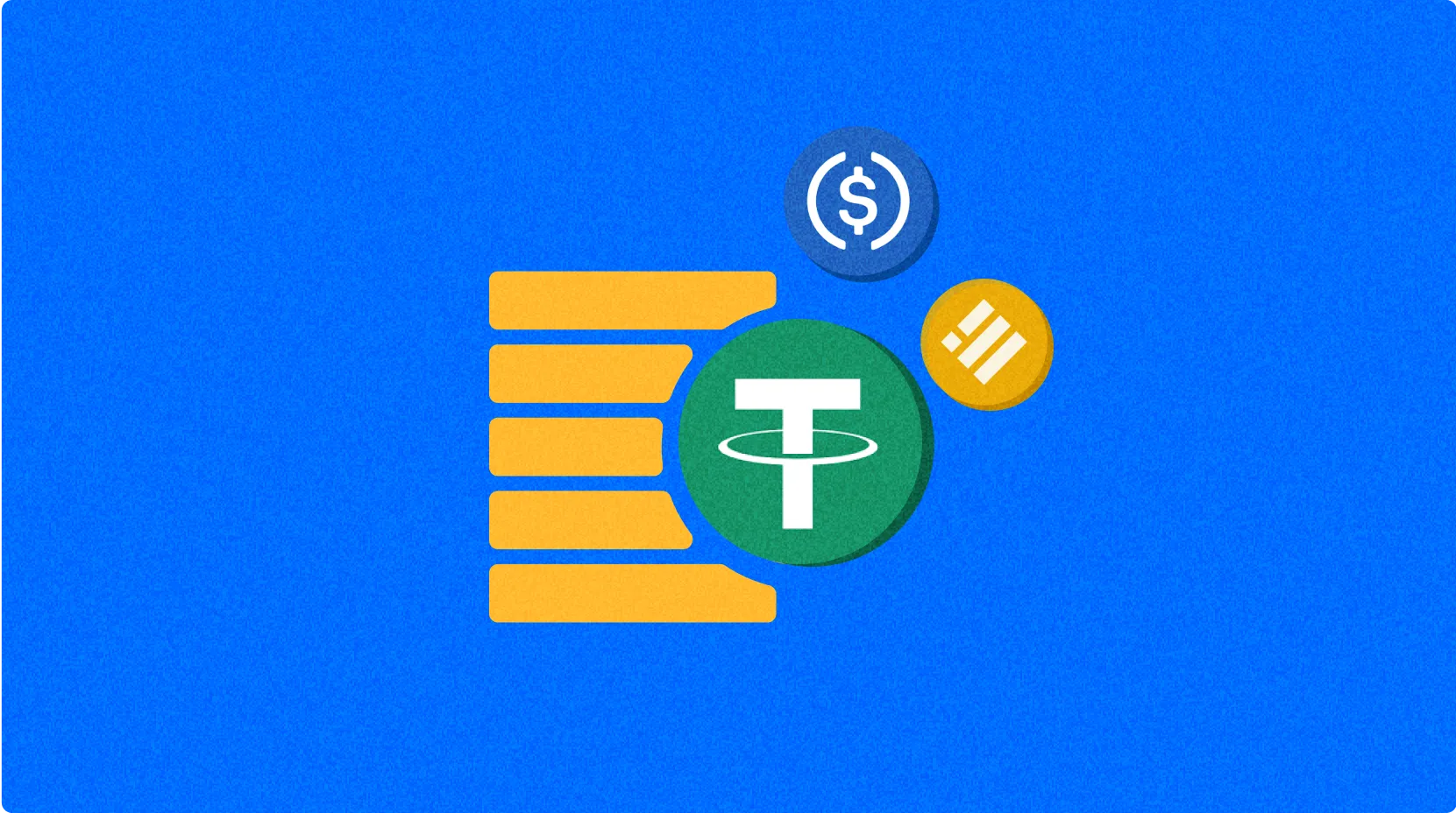Исследование стейблкоинов: как они стимулируют развитие криптовалютной экономики

Что такое стейблкоин?
Стейблкоин - это криптовалюта, разработанная для поддержания стабильной стоимости, обычно привязанной к реальным активам, таким как доллар США или золото. В отличие от других криптовалют с значительными колебаниями цен, цель стейблкоинов - обеспечить надежную среду обмена и стабильное хранилище стоимости. Эта стабильность достигается с помощью различных механизмов, включая фиатный залог, криптовалютный залог и алгоритмическое регулирование.
Важность стейблкоина в криптовалютной экономике
Снизить волатильность
Одним из основных вызовов на рынке криптовалют является его врожденная волатильность. Цены на популярные криптовалюты могут драматически колебаться в короткий период времени, представляя риски для ежедневной торговли и как надежного хранилища стоимости. Стейблкоины решают эту проблему, поддерживая стабильную стоимость, позволяя пользователям защищать свои средства, не полностью выходя из криптоэкосистемы. Эта стабильность особенно важна во время спадов на рынке или значительных колебаний цен, поскольку инвесторам необходимо надежное место для хранения своего капитала в такие моменты.
Улучшенные международные платежи
Стейблкоины предоставляют более быструю и экономически эффективную альтернативу для международных платежей. Они позволяют осуществлять переводы в реальном времени с минимальным временем ожидания, что делает их подходящими для повседневного использования. Например, стейблкоины могут использоваться для одноранговых (P2P) транзакций, позволяя пользователям отправлять деньги друзьям, семье или бизнесу по всему миру, не беспокоясь о волатильности криптовалют. Это особенно полезно для тех, кто переводит деньги в свои родные города, так как это снижает издержки и сокращает время перевода.
Содействовать финансовой инклюзивности
Стейблкоины предоставляют доступную форму цифровой валюты, которая не зависит от волатильных криптовалют и не требует дорогих банковских переводов, способствуя финансовой инклюзии. Например, маленький фермер в отдаленном районе может непосредственно внести заем в виде стейблкоина на свой мобильный кошелек, чтобы приобрести семена и оборудование, и погасить заем через продажу урожая — все это без необходимости посещения физического банковского отделения.
Поддержка децентрализованных финансов (DeFi)
Стейблкоины играют ключевую роль в развитии децентрализованных финансов (DeFi), предоставляя надежную среду обмена и служа как основной компонент на платформах DeFi. Они позволяют пользователям торговать, занимать и предоставлять активы без риска внезапных значительных колебаний стоимости. Эта последовательность способствует доверию и мотивирует более широкое участие пользователей в сфере шифрования. Например, стейблкоины часто используются в качестве залога на платформах кредитования и в рамках стратегий фарминга доходности, предлагая более стабильные доходы.
Типы стейблкоинов
Стейблкоин, обеспеченный фиатными средствами
Стейблкоины, обеспеченные фиатными средствами, являются наиболее распространенным типом, привязанным к традиционным фиатным валютам (например, к доллару США). Каждый токен обеспечен эквивалентным резервом фиатной валюты, который удерживается кастодийным учреждением. Например, Tether (USDT) и USD Coin (USDC) относятся к этому типу и широко используются для торговли и сохранения стоимости. Эти стейблкоины обеспечивают пользователям, ищущим стабильность цены, высокую прозрачность и удобство.
Шифровальная монета залог стейблкоин
Стабильные монеты, обеспеченные шифрованием, используют цифровые активы (такие как Ethereum или другие шифровальные монеты) в качестве залога. Эти стабильные монеты обычно переподстраховываются, чтобы справиться с волатильностью базовых активов. Хорошим примером является DAI, выпущенный MakerDAO. Пользователи блокируют залоговые шифровальные монеты в смарт-контрактах в обмен на DAI. Эта модель, основанная на протоколах блокчейн, а не на банках, более децентрализована, чем стабильные монеты, обеспеченные фиатными средствами.
Стоимость стабильная
Стабильные криптовалюты на основе алгоритмов полагаются на смарт-контракты и рыночные стимулы для корректировки спроса и предложения. Если цена стабильной криптовалюты отклоняется от целевой привязки, алгоритм запускает действия - такие как эмиссия или сжигание токенов - для возвращения цены к целевому диапазону. К таким типам стабильных криптовалют относятся необеспеченные стабильные криптовалюты, которые используют механизм налога сеньоража для поддержания рыночной стоимости близкой к целевой цене.
Проблемы и риски
Хотя стейблкоины имеют множество преимуществ, они также сталкиваются с вызовами. Некоторые стейблкоины имеют проблемы с централизацией, потому что обычно выпускаются и управляются централизованными сущностями. Недостаток прозрачности и регуляторные вопросы также представляют риски, особенно для алгоритмических и шифровально-обеспеченных стейблкоинов. Кроме того, взаимодействие между стейблкоинами на разных блокчейнах также может быть проблемой, например, вызовы, возникающие при обмене между различными сетями блокчейна.
Будущее стейблкоинов
С увеличением регулятивной ясности стабильные монеты, кажется, готовы продолжать расширение, поскольку все больше пользователей ищут стабильную стоимость на рынке шифрования. Например, PayPal запустил собственную стабильную монету (PayPal USD), подчеркивая растущий интерес к стабильным монетам в массовом сознании. Глобальные центральные банки также исследуют цифровые валюты, которые могут интегрироваться с существующими стабильными монетами или представлять конкуренцию.
По мере развития протокола алгоритмические стейблкоины могут оптимизировать свои механизмы привязки, чтобы решить прошлые проблемы и обеспечить более надежные решения. Технологические достижения, такие как боковые цепочки и мосты между цепями, могут улучшить взаимодействие между различными блокчейн-сетями, обеспечивая более плавное движение цифровых активов и стейблкоинов между платформами DeFi, биржами и приложениями в реальном мире.
Заключение
Стейблкоины стали важной частью экосистемы криптовалют, обеспечивая стабильность, надежность и широкие практические применения. Они помогают снизить волатильность, улучшить глобальные платежи, содействуют финансовой инклюзии и поддерживают рост децентрализованных финансов. По мере развития рынка криптовалют стейблкоины могут играть более важную роль, выступая мостом между традиционной финансовой системой и миром цифровых активов. Понимание их преимуществ и вызовов критично для тех, кто стремится эффективно работать в области криптовалют.
“

Почему стейблкоин важен: Погружение в устойчивые активы криптовалюты

Какова будет рыночная капитализация USDC в 2025 году? Анализ рынка стейблкоинов.

Анализ стейблкоинов: Решение Криптоактивов для смягчения Колебаний на Gate.com

Как купить USDC в 2025 году: Полное руководство для новичков-инвесторов

Прогноз цены USDC: Тенденции и инвестиционные перспективы на рынке стейблкоинов на 2025 год

Анализ цены USD Coin в 2025 году: Сравнение с стабильной монетой Ethena и другими

Руководство для начинающих по основным терминам в криптовалюте

Что такое Soulbound Tokens: новый этап развития NFT

Механизм консенсуса Tendermint в технологии блокчейн: основы и принципы работы

Как купить и управлять доменами Ethereum Name Service

Ключевые особенности будущего уникального NFT-проекта





